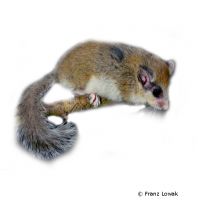Forest Dormouse (Dryomys nitedula)
| Forest Dormouse Dryomys nitedula | |
|---|---|
| Name | Forest Dormouse |
| Name Lat. | Dryomys nitedula |
| Family | Dormice & Hazel Mice |
| Family lat. | Gliridae |
| Order | Rodents |
| Order lat. | Rodentia |
| Origin | Europe, Asia |
| Climate | Temperate - subtropical |
| Habitat | Forest, shrubland |
| Diet | Insects, seeds, green fodder |
| Behavior | Nocturnal; territorial |
| Keeping | Group |
| Care Level | Easy |
| Life Span | 2-6 years |
| Protection | No |
| Metric Units | |
| Size | 8-13 cm |
| Temperature | Room temperature |
| Housing | A: 1 m² / H: 1 m |
| US Units | |
| Size | 3.1"-5.1" |
| Temperature | Room temperature |
| Housing | 10 ft² / 40" hight |
Distribution and habitat
Primarily nocturnal, arboreal dormice are distributed from eastern Europe to northern China. They inhabit a variety of habitats, including deciduous, mixed, coniferous and mountain forests, as well as rocky scrubland, where they live in tree cavities or self-made nests.
Maintenance
Minimum dimensions for the enclosure:
| 2 animals | area: 1 m² | height: 1 m |
| Each additional animal | Area: + 0,5 m² |
A terrarium placed in a bright (no direct sunlight), draught-free and quiet place is recommended, with ventilation openings at the sides, and it must not be tightly closed at the top.
The enclosure must be structured with plenty of climbing opportunities (rocks, roots, branches, etc.) and provide hiding and shelter opportunities (small bird nest boxes, grass nests, ball nests, cork tubes, etc.). They need feeding and drinking containers as well as nest building material (hay, moss, cotton pods). Commercially available small animal litter, hemp or cotton litter covered with some bark mulch, dry leaves and moss is suitable as substrate. The bedding depth should be at least 10 cm. Back and side walls covered with cork offer additional climbing possibilities besides optical aspects. Nail material, such as untreated twigs and branches of fruit trees, as well as a rodent stone must always be available to wear down their teeth. They should be kept at room temperature and their natural day-night rhythm should be respected.
Diet
They feed on a variety of diets depending on the season. The species-specific diet consists of a mixture of dwarf hamster and gerbil food available in specialized stores, supplemented with fruit (grapes, pears, apples, berries, etc.), some fresh food (wild herbs, root vegetables) and a mineral stone. In addition, they need animal protein, such as live insects (crickets, house crickets, mealybug larvae), a hard-boiled hen's egg, cottage cheese, natural yogurt, insect food for hedgehogs or cat food. Better than a nipple drinker is a shallow clay bowl. Although they drink little, water must always be available and, like food, should be offered fresh daily
A varied diet promotes health and prevents deficiency symptoms.
Behaviour and compatibility
They are sociable animals and should only be kept in family groups. Towards foreign animals they behave territorial. Socialization should only take place during the day. At the first signs of incompatibility, the animals should be separated immediately.
Reproduction and breeding
In males, the distance between the anus and the urethral opening is greater than in females.
The gestation period is about 25 days. A litter consists on average of 2-5 young, which are born naked, blind and deaf. After 12-16 days the eyes open. The young are suckled for about 40 days. They are sexually mature after the first hibernation.
Species protection
The European populations are subject to the EU Habitats Directive Anahng IV and are strictly protected!
The proof of purchase is the required proof of origin for the animal. Please keep it safe! Your pet store will be happy to provide you with further information.
Important
They jump far (tail as a balancing organ) and climb very well with the help of their pointed claws and sticky secretions from glands on the pads of their soles. Their sense of smell, hearing and touch is highly sensitive
When food is scarce or temperatures are low, they fall into a hibernation-like rigor (torpor) in which they appear dead. When disturbed, it can take up to 30 minutes for them to awaken. Animals from northern distribution areas keep a pronounced hibernation (October to April).
As escape animals, they require adequate retreat and hiding places. They must not be grabbed or pulled by the tail. Care must be taken to ensure thorough hygiene and contamination must be removed regularly. Further literature can be found in your pet store.
References
Text: petdata; Image: Franz Lowak
Source: W. PUSCHMANN, D. ZSCHEILE, K. ZSCHEILE (2009): Zootierhaltung - Tiere in menschlicher Obhut: Säugetiere, Harri Deutsch Verlag; BMEL (2014): Gutachten über Mindestanforderungen an die Haltung von Säugetieren
- Gemäß § 21 Abs. 5 Tierschutzgesetz idgF
